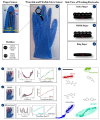Electrochemical Biosensors in Food Safety: Challenges and Perspectives
- PMID: 34063344
- PMCID: PMC8156954
- DOI: 10.3390/molecules26102940
Electrochemical Biosensors in Food Safety: Challenges and Perspectives
Abstract
Safety and quality are key issues for the food industry. Consequently, there is growing demand to preserve the food chain and products against substances toxic, harmful to human health, such as contaminants, allergens, toxins, or pathogens. For this reason, it is mandatory to develop highly sensitive, reliable, rapid, and cost-effective sensing systems/devices, such as electrochemical sensors/biosensors. Generally, conventional techniques are limited by long analyses, expensive and complex procedures, and skilled personnel. Therefore, developing performant electrochemical biosensors can significantly support the screening of food chains and products. Here, we report some of the recent developments in this area and analyze the contributions produced by electrochemical biosensors in food screening and their challenges.
Keywords: antibiotics; bacteria; contaminants; electrochemical biosensors; food; pesticides; safety; toxins.
Conflict of interest statement
The author declares no conflict of interest.
Figures













Similar articles
-
Electrochemical (Bio)Sensors for Toxins, Foodborne Pathogens, Pesticides, and Antibiotics Detection: Recent Advances and Challenges in Food Analysis.Biosensors (Basel). 2025 Jul 21;15(7):468. doi: 10.3390/bios15070468. Biosensors (Basel). 2025. PMID: 40710117 Free PMC article. Review.
-
Electrochemical biosensors: The beacon for food safety and quality.Food Chem. 2025 May 30;475:143284. doi: 10.1016/j.foodchem.2025.143284. Epub 2025 Feb 9. Food Chem. 2025. PMID: 39956060 Review.
-
Engineering nanomaterials-based biosensors for food safety detection.Biosens Bioelectron. 2018 May 30;106:122-128. doi: 10.1016/j.bios.2018.01.049. Epub 2018 Feb 1. Biosens Bioelectron. 2018. PMID: 29414078 Review.
-
Novel Nondestructive Biosensors for the Food Industry.Annu Rev Food Sci Technol. 2021 Mar 25;12:539-566. doi: 10.1146/annurev-food-062520-082307. Annu Rev Food Sci Technol. 2021. PMID: 33770468 Review.
-
Recent advances and challenges in graphene-based electrochemical biosensors for food safety.Anal Biochem. 2025 Aug;703:115866. doi: 10.1016/j.ab.2025.115866. Epub 2025 Apr 17. Anal Biochem. 2025. PMID: 40252891 Review.
Cited by
-
Not Only Graphene Two-Dimensional Nanomaterials: Recent Trends in Electrochemical (Bio)sensing Area for Biomedical and Healthcare Applications.Molecules. 2023 Dec 27;29(1):172. doi: 10.3390/molecules29010172. Molecules. 2023. PMID: 38202755 Free PMC article. Review.
-
Single-Walled Carbon Nanotube-Modified Gold Leaf Immunosensor for Escherichia coli Detection.ACS Omega. 2024 May 9;9(20):22277-22284. doi: 10.1021/acsomega.4c01599. eCollection 2024 May 21. ACS Omega. 2024. PMID: 38799361 Free PMC article.
-
Recent Advances in Electrochemical Sensing Strategies for Food Allergen Detection.Biosensors (Basel). 2022 Jul 9;12(7):503. doi: 10.3390/bios12070503. Biosensors (Basel). 2022. PMID: 35884306 Free PMC article. Review.
-
Organic Electronics in Biosensing: A Promising Frontier for Medical and Environmental Applications.Biosensors (Basel). 2023 Nov 7;13(11):976. doi: 10.3390/bios13110976. Biosensors (Basel). 2023. PMID: 37998151 Free PMC article. Review.
-
Lab-on-a-Chip Electrochemical Biosensors for Foodborne Pathogen Detection: A Review of Common Standards and Recent Progress.Biosensors (Basel). 2023 Feb 1;13(2):215. doi: 10.3390/bios13020215. Biosensors (Basel). 2023. PMID: 36831981 Free PMC article. Review.
References
-
- Campuzano S., Yáñez-Sedeño P., Pingarrón J.M. Electrochemical Affinity Biosensors in Food Safety. Chemosensors. 2017;5:8. doi: 10.3390/chemosensors5010008. - DOI
-
- Scognamiglio V., Arduini F., Palleschi G., Rea G. Biosensing technology for sustainable food safety. TrAC Trends Anal. Chem. 2014;62:1–10. doi: 10.1016/j.trac.2014.07.007. - DOI
-
- Caballero B., Trugo L., Finglas P. Encyclopedia of Food Sciences and Nutrition: Volumes 1–10. Elsevier; New York, NY, USA: 2003.
-
- Pividori M.I., Alegret S. Electrochemical biosensors for food safety. Contrib. Sci. 2010;6:173–191.
Publication types
MeSH terms
Substances
LinkOut - more resources
Full Text Sources
Medical

